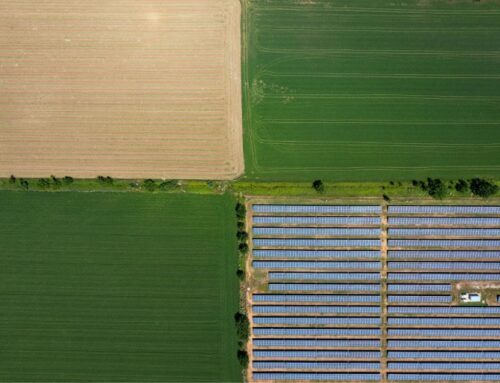U.S. Renewable Energy Market Poised for Strong Growth to 893.2 GW by 2032
June 10, 2025
06-10-2025 07:50 AM CET | Energy & Environment
The U.S. renewable energy market has been experiencing rapid expansion, driven by technological innovations, government incentives, and growing environmental consciousness. As the world seeks to address the effects of climate change, renewable energy sources such as solar, wind, and battery storage are playing a vital role in reducing carbon emissions and promoting sustainability. In this article, we will provide an in-depth analysis of the U.S. renewable energy market, exploring its growth potential, market segments, regional insights, and key trends driving the sector forward.
Overview of the U.S. Renewable Energy Market
The U.S. renewable energy market is projected to grow significantly in the coming years. In terms of installed base, the market is expected to increase from 481.5 Gigawatts (GW) in 2025 to 893.2 GW by 2032, reflecting a compound annual growth rate (CAGR) of 12.7%. This growth can be attributed to several factors, including the ongoing decline in the costs of solar and wind energy, favorable government policies, and increased demand from both the private and public sectors.
The leading segment within the U.S. renewable energy market is solar energy, which is expected to capture 49.2% of the market share in 2025. Technological advancements, such as the development of bifacial panels and tracking systems, are boosting the efficiency of solar energy systems. Furthermore, the industrial sector is projected to lead the market with a 54.2% share in 2025, driven by the increasing number of large-scale industrial parks and warehouses that offer vast rooftop spaces for solar and wind energy installations.
Elevate your business strategy with comprehensive market data. Request a sample report now: https://www.persistencemarketresearch.com/samples/35264
Market Statistics and Key Growth Drivers
The growth trajectory of the U.S. renewable energy market is supported by several key growth drivers. The first major driver is the ongoing decarbonization efforts in both the private and public sectors. Tech giants like Google, Amazon, and Microsoft are leading the way by committing to 100% renewable energy usage, contributing to the increasing demand for large-scale renewable energy projects such as solar and wind farms.
Government policies, including subsidies, tax credits, and grants, are also playing a crucial role in driving the growth of renewable energy installations. For example, in March 2023, the U.S. Department of Agriculture (USDA) launched a grant scheme aimed at helping small businesses and agricultural producers in rural areas invest in renewable energy systems. This initiative is expected to provide financial relief to businesses looking to adopt renewable energy technologies, further accelerating market growth.
Key Highlights from the Report
➤ The U.S. renewable energy market size is estimated to reach 481.5 GW by 2025.
➤ Solar energy is forecasted to hold a 49.2% share of the market in 2025.
➤ The industrial application segment is expected to account for 54.2% of the market share in 2025.
➤ The Southeast U.S. is predicted to be the leading geographical region in the market in 2025.
➤ Solar, wind, and battery storage costs are rapidly declining, making renewables more competitive than fossil fuels.
➤ Offshore wind energy is expected to grow on the U.S. East Coast and enter early-stage development in the Gulf and West regions.
Market Segmentation
By Product Type
The U.S. renewable energy market is primarily segmented into solar, wind, and battery storage technologies. Solar energy, as the leading renewable energy source, is expected to capture a significant market share, owing to continuous technological advancements and reduced costs. In particular, bifacial panels and solar tracking systems have enhanced the efficiency of solar installations, driving widespread adoption. Wind energy, both onshore and offshore, is also poised for substantial growth, with a focus on large-scale projects in the Southeast U.S. and along the East Coast. Battery storage systems, critical for ensuring grid reliability and energy security, are increasingly becoming a key component of renewable energy systems.
By End-User
The end-user segmentation of the U.S. renewable energy market includes residential, commercial, and industrial sectors. The industrial sector is expected to be the leading end-user, driven by the availability of large-scale installations and significant rooftop space for solar and wind energy systems. Commercial establishments are also adopting renewable energy solutions to reduce energy costs and meet sustainability targets. Additionally, the residential sector is expected to see an uptick in renewable energy adoption, especially solar panels, as more consumers seek cost-effective and environmentally friendly alternatives.
Regional Insights
Southeast U.S.
The Southeast U.S. is predicted to dominate the renewable energy market in 2025, owing to favorable environmental conditions such as high solar irradiance and the availability of ample land for large-scale renewable energy projects. The region has become a hub for solar energy development, with states like Florida and Georgia leading the charge. Government incentives and supportive policies further contribute to the region’s growth in the renewable energy sector.
East Coast and Offshore Wind
The East Coast of the U.S. is expected to see rapid growth in offshore wind energy projects. With large-scale offshore wind farms under development, this region is becoming a critical player in the U.S. renewable energy landscape. States like Massachusetts, Rhode Island, and New York are leading the charge, with numerous offshore wind projects underway. These developments are expected to bolster the market share of wind energy in the coming years.
Market Drivers
The U.S. renewable energy market is poised to expand rapidly due to several key drivers. The first and most significant driver is the increasing decarbonization targets set by both corporations and governments. Leading technology companies, such as Microsoft, Google, and Amazon, are committing to 100% renewable energy, and this has triggered a surge in demand for large-scale renewable energy projects. Corporate power purchase agreements (PPAs) are expected to increase, further fueling the need for renewable energy capacity.
Another key driver is the ongoing modernization of the U.S. electricity grid. The U.S. Department of Energy has been investing billions of dollars in upgrading transmission infrastructure to improve grid resilience and accommodate more renewable energy sources. This modernization will make it easier to integrate renewable energy from remote locations to urban centers, further accelerating market growth.
Market Restraints
Despite the promising growth potential, several challenges could hinder the development of the U.S. renewable energy market. One significant restraint is the high initial capital investment required for renewable energy infrastructure, particularly for solar and wind energy projects. Although the costs of renewable energy technologies have decreased over time, the upfront capital remains a barrier for many small businesses and rural areas.
Additionally, grid infrastructure in some regions of the U.S. may not be equipped to handle the increasing influx of renewable energy. This could lead to issues with grid stability and reliability, particularly during times of peak demand. The need for substantial investment in grid modernization is therefore crucial to ensure the long-term success of the renewable energy sector.
Market Opportunities
The U.S. renewable energy market is brimming with opportunities, particularly in the areas of offshore wind, battery storage, and energy efficiency. Offshore wind energy, in particular, holds immense potential, with vast untapped resources along the East Coast. Early-stage developments, such as those in Massachusetts and New York, are expected to catalyze future growth in this sector.
Battery storage technology also represents a significant opportunity, as energy storage solutions are essential for ensuring the reliability of renewable energy systems. As the cost of batteries continues to decline, adoption is expected to grow, supporting grid stability and enabling renewable energy to be stored for use during times of low generation.
Do You Have Any Query Or Specific Requirement? Request Customization of Report: https://www.persistencemarketresearch.com/request-customization/35264
Frequently Asked Questions (FAQs)
➤ How Big is the U.S. Renewable Energy Market?
➤ Who are the Key Players in the U.S. Renewable Energy Market?
➤ What is the Projected Growth Rate of the U.S. Renewable Energy Market?
➤ What is the Market Forecast for the U.S. Renewable Energy Sector for 2032?
➤ Which Region is Estimated to Dominate the U.S. Renewable Energy Industry Through 2032?
Company Insights
✦ NextEra Energy
✦ Tesla
✦ Orsted
✦ First Solar
✦ Vestas Wind Systems
✦ General Electric
■ NextEra Energy recently announced a partnership with Florida Power & Light Company to expand solar power generation capacity in Florida.
■ Tesla launched its latest battery storage solution, aimed at providing affordable and efficient energy storage for residential and commercial users.
In conclusion, the U.S. renewable energy market is set for significant growth in the coming years, driven by technological advancements, supportive government policies, and a growing commitment to sustainability from both the private and public sectors. With increasing adoption of solar, wind, and battery storage technologies, the renewable energy landscape in the U.S. is evolving rapidly, creating both challenges and opportunities for market participants. As the transition to clean energy continues, the U.S. is expected to remain at the forefront of global renewable energy development.
Contact Us:
Persistence Market Research
G04 Golden Mile House, Clayponds Lane
Brentford, London, TW8 0GU UK
USA Phone: +1 646-878-6329
UK Phone: +44 203-837-5656
Email: sales@persistencemarketresearch.com
Web: https://www.persistencemarketresearch.com
About Persistence Market Research:
At Persistence Market Research, we specialize in creating research studies that serve as strategic tools for driving business growth. Established as a proprietary firm in 2012, we have evolved into a registered company in England and Wales in 2023 under the name Persistence Research & Consultancy Services Ltd. With a solid foundation, we have completed over 3600 custom and syndicate market research projects, and delivered more than 2700 projects for other leading market research companies’ clients.
Our approach combines traditional market research methods with modern tools to offer comprehensive research solutions. With a decade of experience, we pride ourselves on deriving actionable insights from data to help businesses stay ahead of the competition. Our client base spans multinational corporations, leading consulting firms, investment funds, and government departments. A significant portion of our sales comes from repeat clients, a testament to the value and trust we’ve built over the years.
This release was published on openPR.
Search
RECENT PRESS RELEASES
Related Post




